White marble floors create a luxurious foundation for kitchens, offering timeless beauty with their distinctive veining. The bright surface reflects light, making small kitchens appear more spacious and airy. Carrara and Calacatta marble are popular choices, with subtle gray veins that add depth without overwhelming the space. Though porous, properly sealed marble resists stains and moisture effectively. The cool surface feels refreshing underfoot, ideal for warm climates. This natural stone elevates kitchen designs from rustic farmhouse to sleek modern aesthetics with equal grace.
Maintenance requirements for white marble kitchen floors demand attention. Daily sweeping prevents abrasive dirt from scratching the polished surface. Immediate cleanup of spills—especially acidic substances like wine or citrus—prevents etching. pH-neutral cleaners preserve the sealant without damaging the stone. Resealing every 6-12 months maintains protection in high-traffic cooking areas. Area rugs near sinks and stoves catch debris while adding warmth. Though requiring more care than some materials, many homeowners find marble’s beauty worth the extra effort.
Design versatility makes white marble suitable for various kitchen styles. Pairing with dark cabinetry creates striking contrast, while all-white schemes achieve seamless sophistication. The natural veining ensures no two floors are identical, adding organic character. Large-format tiles minimize grout lines for a cleaner look. Honed finishes provide better slip resistance than polished surfaces near wet areas. Brass or gold hardware complements marble’s warm undertones beautifully. These adaptable qualities make it a favorite among designers seeking elegant yet flexible flooring.
Installation considerations impact long-term performance. Professional installation ensures proper subfloor preparation and leveling. Epoxy grout resists stains better than traditional cement grout in kitchen environments. Expansion joints accommodate natural stone movement. Radiant heating systems can be installed beneath to eliminate cold floors in winter. The weight of marble requires structural verification in upper-level kitchens. These technical aspects guarantee a flawless foundation for years of use.
Cost factors balance marble’s benefits against practical realities. While initially more expensive than ceramic or porcelain, marble adds significant home value. Budget-conscious homeowners might opt for marble-look porcelain as an alternative. The long lifespan—centuries with proper care—justifies the investment for many. Minor scratches can be polished out, and severe damage repaired by professionals. For those who appreciate natural materials, white marble floors remain an aspirational kitchen feature that never goes out of style. Its ability to develop a patina over time adds to the charm for many enthusiasts.
Herringbone Pearl White Thassos Shell Tile in 2020 Shell tiles, Unique tile floor, Master
Fireplace, white shiplap, stone ledgestone, nuetral colors, hickory floors. Shiplap fireplace
Related Posts:





